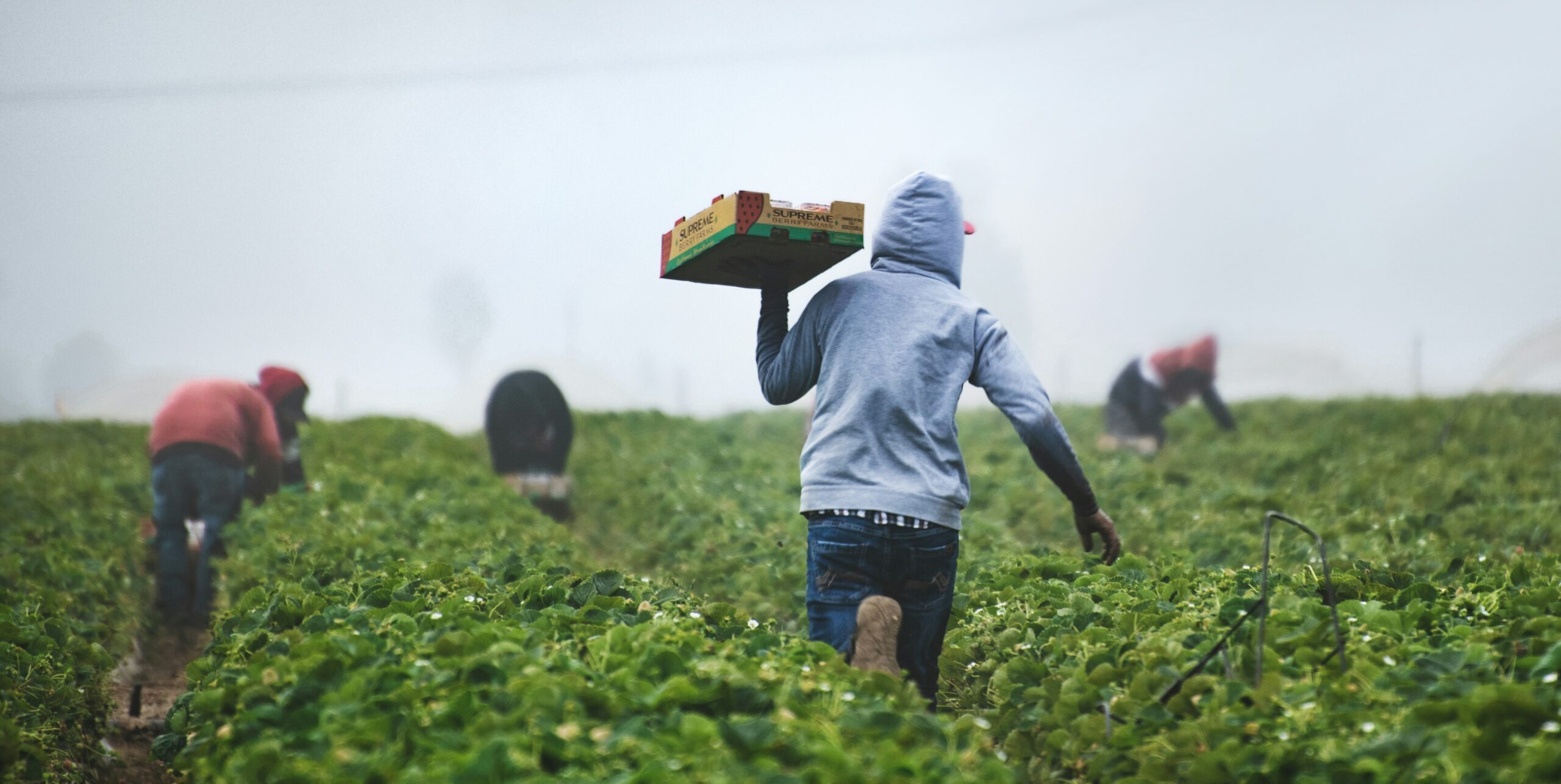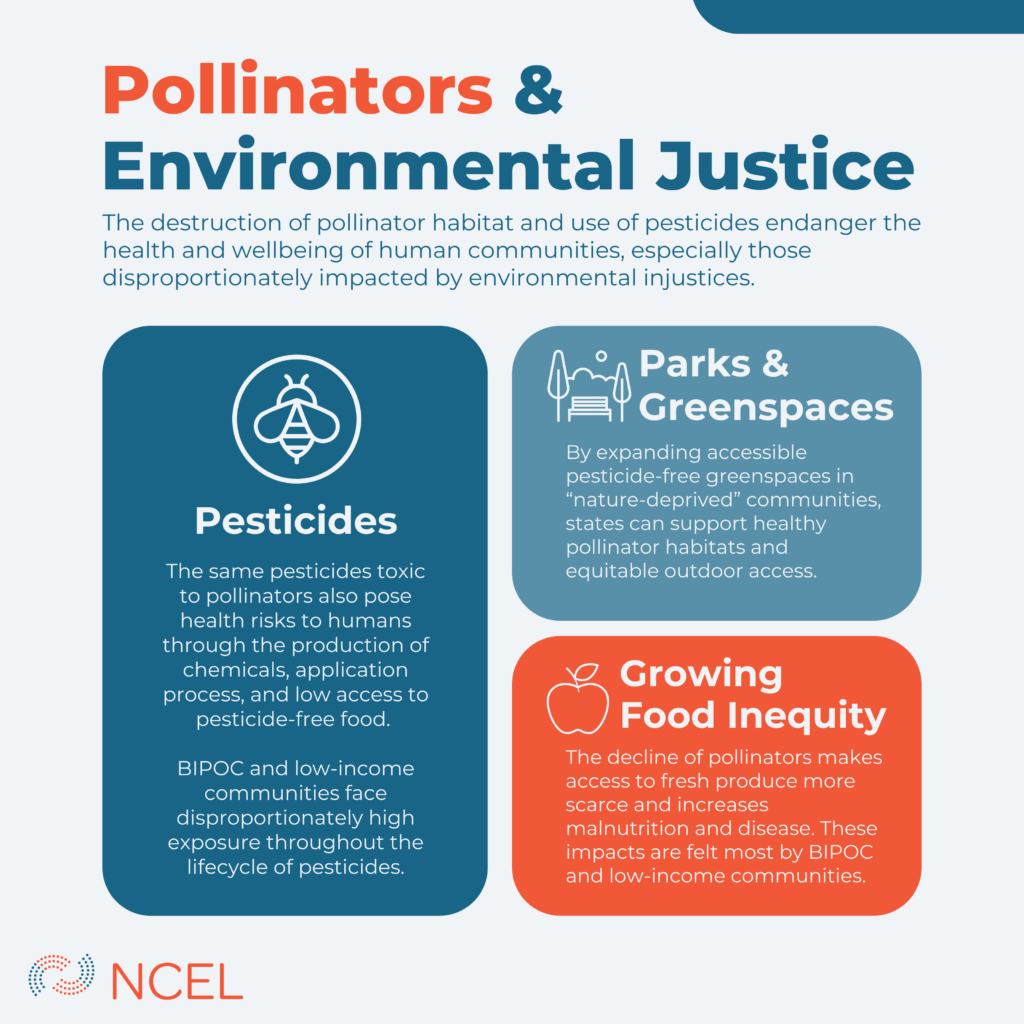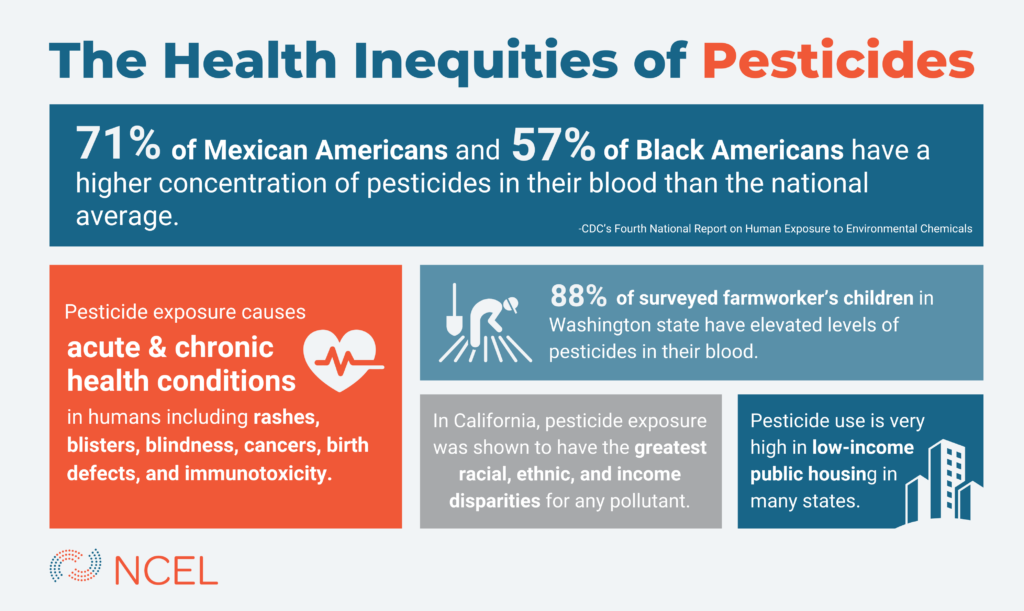
Blog
Six Opportunities for States to Reduce Unjust Pesticide Exposure and Boost Pollinator Health
June 18, 2024
Overview
Studies show it is almost certain that all Americans have traceable amounts of pesticides in their bloodstream. However, people of color bear a disproportionate pesticide burden compared to the national average. According to the CDC’s Fourth National Report on Human Exposure to Environmental Chemicals, Mexican Americans and Black Americans have a higher blood concentration of pesticides than 71% and 57% of Americans respectively.
- Catch Up Quick: Pesticide exposure can cause both acute and chronic human health conditions including rashes, blisters, blindness, cancers, birth defects, and immunotoxicity. Pesticides are also contributing to a global decline in pollinator species which threatens access to fresh food and produce, especially for low-income communities, people of color, and Tribal nations.

Due to the lack of federal action to address pesticide exposure, states can lead the way to mitigate such systemic issues.
The Problem: Pesticides and Environmental Injustice
Going beyond national data tracking and trends, disproportionate pesticide exposure is startling at the state level. In California, pesticides are the pollutant with the greatest exposure disparity between white and non-white individuals. Nearly all of California’s pesticide use occurs in zip codes with the highest percentage of people of color. Those most often exposed generally live near a pesticide manufacturing plant or are farmworkers.

Farmworkers, the majority of which identify as Hispanic, are highly exposed due to their role in pesticide application. Yet monitoring in Idaho found that farmworkers face persistent pesticide exposure even after the spraying season concludes due to remaining pesticide residues. Such exposure can also spread to the family, with a Washington study finding 88% of surveyed farmworker’s children having elevated pesticide blood levels. Pesticide home exposure is also prevalent within dense inner-city housing developments, with studies finding 80% of New York public housing facilities applying pesticides on a regular basis and pesticide residues in all surveyed Boston public housing units.
State Opportunities to Address Disproportionate Pesticide Exposure
Disproportionate pesticide exposure is a systemic issue embedded in a broader environmental justice and civil rights context. State action today can alleviate a portion of the pesticide burden placed upon communities of color across the nation.
1. Regulate Pesticides
Pesticide-use regulation may be the most direct strategy to reduce the amount of pesticide exposure throughout a state. Such regulation can focus on a range of restrictions on pesticide use, from residential to agricultural.
- State Example: In 2024, 19 states considered or enacted 79 pieces of pesticide-regulation legislation. To better understand these policies, please view NCEL’s Pesticide Briefing Book for the full suite of pesticide regulation policy options.

2. Institute Pollinator-Friendly Urban Greenspaces
The Black Institute found that urban greenspaces accessed by communities of color are often treated with more pesticides than greenspaces in predominantly white neighborhoods. Eliminating pesticides from such greenspaces can increase native pollinator and invertebrate populations, allowing communities of color to experience the benefits of a pesticide-free park.
3. Implement State Biological Monitoring Programs
California and Washington are the only two states to conduct biological monitoring for workers who are frequently exposed to pesticides. These programs monitor worker’s blood pesticide levels, allowing chronic pesticide exposure to be identified and addressed. Such programs can protect workers from the worst health impacts of chronic pesticide exposure. Biological monitoring is common for other industries with OSHA developing screening protocols for 25 hazardous chemicals workers experience at work.
- State Example: The Washington Biomonitoring Pesticides program tracks blood pesticide levels among Washington farmworkers and can serve as a decision-making tool to reduce the risk of pesticide-related illness.
4. Enforce the Worker Protection Standard
The federal Worker Protection Standard (WPS) provides a minimum level of protection for farmworkers against pesticides. Yet, inspections and appropriate enforcement for the WPS is lacking. Less than 1% of pesticide-using agricultural entities are investigated for WPS compliance and only 19% of violating entities are given a penalty. States conduct most of the compliance inspections and penalties; therefore, states can mandate more frequent inspections and impose stricter penalties.
- State Example: Hawaii S.R.61 requests the Department of Agriculture to submit a report on statewide WPS pesticide inspections and to strengthen penalties for pesticide violations.
5. Require Labeling in Spanish
Most agricultural workers are Spanish-speaking immigrants with little ability to read or write in English. However, all pesticide labels that detail safe handling are in English. States can ensure these labels are made in both English and Spanish to deliver safety information in an accessible manner to all pesticide users.
- State Example: Minnesota H.F.2798 mandates that “pollinator lethal” pesticides have a precautionary statement in the environmental hazards section of the insecticide product label. States can also mandate that pesticide labels include a Spanish translation.
6. Fund Pest-Management Alternative Strategies
Strategies such as integrated pest management (IPM) seek to eliminate or drastically reduce the amount of pesticides used to solve pest problems. IPM may be especially useful in mitigating pesticide exposure in an urban environment while also solving the root of the pest pressure.
- State Example: California A.B.2113 would define integrated pest management and introduce uniformity for state IPM programs.
Learn More and Take Action
To learn more about how your state can reduce harmful and disproportionate human exposure to pesticides, visit NCEL’s webpages on Pesticides and Pollinators, and download our Pesticides Briefing Book.

Empower State Environmental Champions
Your donation funds the fight for equitable actions that protect the environment and our health.
Donate